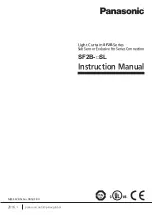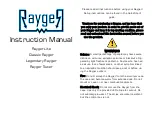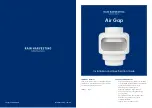
8.
11. Upon seeing this solid flow of water coming out of the
Model LP Dry Valve Actuator, open valves M (Rapid-Air
Fill Shutoff Valve) and K (Regulated Air Shutoff Valve),
thereby rapidly applying compressed air or nitrogen
into the Model LP Dry Valve Actuator (and the sprinkler
system) until the pressure conforms to Table A levels, as
indicated by the system air pressure gauge. The Model
LP Dry Valve Actuator will eventually close during this
pressurizing process and the water will stop flowing into
the drip cup. At this point, the pressure gauge which
indicates push-rod chamber pressure will equalize to
the available water supply pressure. Once the actuator
is setup correctly, close the Rapid-Air Fill Shutoff Valve,
valve M. Keep the Regulated Air Shutoff Valve, valve
K open.
Note:
If 1) the optional air compressor is in-
stalled and 2) the dryness of the supervisory air is criti-
cal (i.e. freezer applications), valve G should be closed
during this step as to not let any moist air into the sprin-
kler system. Valve G may be re-opened once the Model
LP Dry Valve Actuator has been successfully set up with
a dry air supply (i.e., nitrogen) in order to provide any
make up air that, if not supplied, could cause a potential
low-air alarm condition.
12. Open valve N.
13. If the Model B1 Accelerator Kit is installed, open valve
P. Prior to opening valve P, be sure that the Model B1
Accelerator has been successfully reset per Reliable
Technical Bulletin 323.
Note:
The B1 Accelerator re-
quires a minimum of 15 psi (1.0 bar) of supervisory gas
pressure for proper operation.
14. Close the manual pull station that is assembled to the
exterior of the PrePaK’s 24VDC Terminal Box and then
press the system reset button on the Potter PFC-4410-
RC Panel.
Note:
All other detection devices must be
reset before the releasing/control panel can be reset.
15. Slightly open the main valve controlling water supply to
the Model DDX Deluge Valve. This will fill the deluge
valve’s volume beneath its clapper with water. Slightly
open the main drain valve, valve B, to vent any trapped
air. Once any trapped air has been vented, close valve
B. Making sure that valve N is open, observe if water
leaks through the ball drip valve, valve F, into the drip
cup (Or into the 1” Drain manifold trough the clear tub-
ing for 8” System). If no leakage occurs, the deluge
valve’s clapper is sealed. Fully open the main valve
controlling the water supply to the Model DDX Deluge
Valve. Visually verify by the position of its indicator flag
that it is fully-opened.
16. Verify that valve A is open.
17. Secure the handle of the Model B Manual Emergency
Station, valve D, in the OFF position with a nylon tie
(supplied with the assembly).
18. Press the system reset button on the Potter PFC-4410-
RC Panel to place the system in the ready condition.
Note:
All detection devices must be reset before the
panel can be reset.
Inspection And Testing
Refer to Figs. 10, 11 or 12 (depending on system size)
1. Water
supply
— Verify that the valve controlling water
supply to the deluge valve is opened fully and properly
monitored.
2. Alarm
line
— Verify that valve C is opened and remains
in this position.
3. Other trimming valves
— Verify that valve N is open
as well as all of the pressure gauge’s ¼” 3-way valves.
Valves D, E, and H should be closed.
4. Ball drip valve F
— Push in on the plunger to be sure
the ball check is off its seat. If no water appears, the del-
uge valve’s water seat is tight. Inspect the small bleed
hole located on the underside of the Model DDX Deluge
Valve’s pushrod chamber for leakage.
5. System air pressure
— Verify that system’s air pres-
sure and water supply pressures are in conformance
with the values posted in Table A.
6. Releasing
device
— Check the outlet of the releasing
device (i.e., solenoid valve, Model LP Dry Valve Actua-
tor or the Model B Manual Emergency Station, valve D)
for leakage. Also verify that tubing drain lines from re-
leasing devices are not pinched or crushed which could
prevent proper releasing of the deluge valve.
7. Testing
alarms
— Open valve E permitting water from
the supply to flow to the alarm pressure switch and to
the mechanical sprinkler alarm (if present). After test-
ing, close this valve completely. Push in on the plunger
of ball drip valve F until all of the water has drained from
the alarm line.
8. Operational
test
— Open the Model B Manual Emer-
gency Station, valve D.
Note:
An operational test will
cause the Deluge Valve to open and flow water into the
sprinkler system.
9.
Secure the Model B Manual Emergency Station, valve
D, in the OFF position with a nylon tie (included with the
assembly) after the deluge valve is reset.
Testing the Model DDX Deluge Valve Without
Flowing Water
Refer to Figs. 10, 11 or 12 (depending on system size)
1. Close the valve controlling water supply to deluge valve
and open the main drain valve B.
2. Verify that valve A is open, allowing water to enter the
push rod chamber.
3. Close off the air/nitrogen supply to the sprinkler system.
4. Decrease pneumatic pressure in the system by open-
ing the ¼” angle valve, valve H, deluge valve until the
Model LP Dry Valve Actuator operates. This will be in-
dicated by a sudden drop of water pressure on the air
pressure gauge. This operation of the actuator will vent
the water pressure from itself back to the solenoid valve
which is still closed. The push-rod chamber of the del-
uge valve should still be pressurized at this point.
Summary of Contents for DDX PrePaK
Page 3: ...3 Fig 1 ...
Page 11: ...11 Fig 3 ...
Page 12: ...12 Fig 4 ...
Page 13: ...13 Fig 5 ...
Page 14: ...14 Fig 6 ...
Page 15: ...15 Fig 7 ...
Page 16: ...16 Fig 8 ...
Page 17: ...17 Fig 9 ...
Page 18: ...18 Fig 10 ...
Page 19: ...19 ...
Page 20: ...20 Fig 11 ...
Page 21: ...21 ...
Page 22: ...22 Fig 12 ...
Page 23: ...23 ...
Page 25: ...25 Fig 13 ...
Page 27: ...27 Fig 14 ...
Page 28: ...28 Fig 15 ...
Page 29: ...29 Fig 16 ...









































